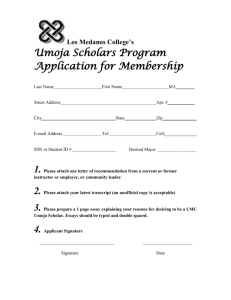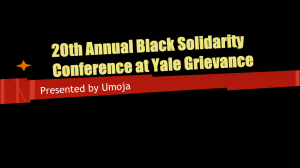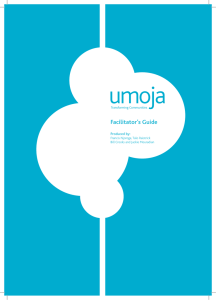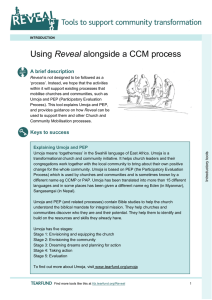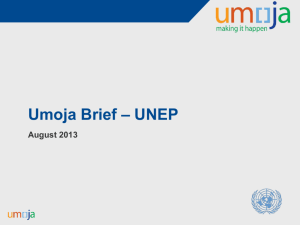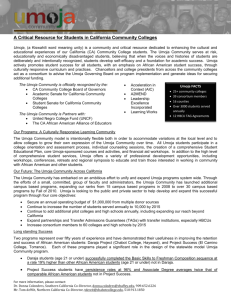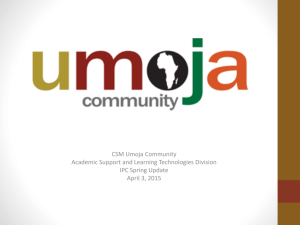Overview and purpose of Umoja 7 6
advertisement
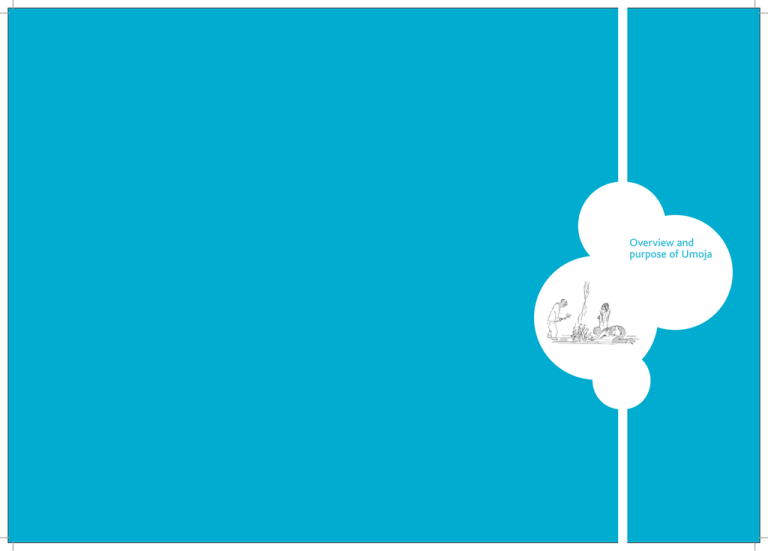
6 Umoja: Facilitator’s Guide Overview and purpose of Umoja 7 8 Umoja: Facilitator’s Guide Overview and Purpose of Umoja 1. What is the purpose of Umoja? 2. What are the benefits of Umoja? Umoja is about giving the local church a vision for their community. Through Bible studies and interactive activities, Umoja is about enthusing and empowering the church to go out into the community and help people identify and address their needs with their own resources. Umoja builds on the strengths and hopes of a church group that want to make a difference in their community. There are a number of benefits to the church and community of doing Umoja. Benefits to the church • Grows as a positive influence within the community. • Helps the church to reflect on the Bible and its role to meet the needs of others. • Helps identify resources in the church. • Builds relationships. • Confidence is built by working in a team. “If you do away with the yoke of oppression, with the pointing finger and malicious talk, and if you spend yourselves on behalf of the hungry and satisfy the needs of the oppressed, then your light will rise in the darkness, and your night will become like the noonday. The Lord will guide you always; he will satisfy your needs in a sun scorched land and will strengthen your frame. You will be like a well-watered garden like a spring whose waters never fail. Your people will rebuild the ancient ruins and raise up the age-old foundations; you will be called Repairer of Broken Walls, Restorer of Streets with Dwellings.” Isaiah 58:9-12 • Helps the church become a growing community, sharing experiences and achievements. Benefits to the community • Self-reliance. • Sense of purpose. • Self-esteem. • Sustainable change. • Sense of hope and well being. • Greater ability to adjust to changes in culture and the environment. • Improved community relationships. 9 10 Umoja: Facilitator’s Guide Overview and Purpose of Umoja 3. What are the key stages of Umoja? Stage 3. Dreaming dreams and planning for action Stage 1. Envisioning and equipping the church Umoja is about working with the church leaders and members to help them understand their biblical responsibility to serve their local communities. The process will help to build the confidence of the church members and help them identify their strengths and resources, so that they can believe that change is possible. Stage 2. Envisioning the community The church, once envisioned, works to bring the community together to discuss the needs and resources of the community, to gather and analyse information, and to decide what needs to change. Once everyone is agreed on what needs to change, the church and community work together in developing a vision for the future and planning how they can bring about this change, using their own resources. This will involve thinking about setting up a project in the community. A project is defined as an initiative which is designed and run by the community using its own resources. Stage 4. Taking action Once the community start taking action, all sorts of advice is provided to help to ensure that the plans are carried out and positive change happens. Stage 5. Evaluation The last stage should be a review of how the church and the community have worked together to plan and run projects to improve the lives of individuals and the community. This should also include insights and learning for how the process of motivating and encouraging the church and community to work together could be improved in the future. Within each stage there are parts which are divided up into steps. 11 12 Umoja: Facilitator’s Guide Overview and Purpose of Umoja The first cycle of Umoja The repeated cycles of Umoja The five distinct stages can be seen in the form of a cycle which starts with envisioning the church and finishes with the evaluation. As the community gain confidence and put in place structures to manage different projects, they can then repeat the cycles of Umoja a number of times until it becomes part of community life. Stage 3. Dreaming dreams and planning for action Stage 4. Taking action Evaluation and learning from our experience Stage 2. Envisioning the community Stage 5. Evaluation Even more community action More community action Dreaming dreams Stage 1. Envisioning and equipping the church Community action Envisioning the community Envisioning and equipping the church With each cycle of Umoja, it is important that the church and community reflect on the lessons they have learnt from previous projects and apply them to new ones. 13 14 Overview and Purpose of Umoja 4. How to set up an Umoja programme When setting up an Umoja programme you need to consider the following steps: 1. Once the church and community have been identified, it is important to set up a meeting with both church and community leaders to discuss the five stages and what is involved. This is important so that they can mobilise all the community members for a series of small workshops. At this meeting it is also useful to think about when the workshops could happen so that they do not clash with busy times of the year and are at the time of day which is both accessible to men and women. This step can take two or three months. 2. It is good to launch this initiative in a church service and to use some of the spiritual reflections as part of the sermon. This makes the approach distinctive as a churchbased initiative. 3. In most cases it has been found that it is good to have a workshop once a month so that the church and the community can work hard to do their research and planning between the workshops and feedback to the facilitator. However, this depends on the time commitments of the participants and flexibility may be needed and time scales may vary. Overview and Purpose of Umoja 4. After the first workshop, which should be an introduction, it is important that one or two people are appointed who can help the church and community follow up the actions they have planned and to work closely with the facilitator. These people should be men and women of integrity and widely respected by the community. They may also be required to set up a small group called the local co-ordination group (LCG) to co-ordinate the different projects. 5. Some of the roles of this co-ordination group are to oversee the programme, take responsibility for setting up the workshops and make sure records are kept and shared with the wider community. They should also monitor the progress of the programme and work with the facilitator on any changes needed. 6. As the programme starts, it is important to share what is going on with local authorities and officials. 7. The LCG should include a chairperson or co-ordinator, a secretary, a treasurer, and other key members who are good at organising and bringing insight. It is sometimes useful if the church leaders are not the chair or coordinator as this can help people talk more freely. For further details on the different roles of the people involved in the process, see pages 64-66. 8. The LCG should meet regularly as a group to plan ahead, both for the workshops, and for the activities that need to be followed up between the workshops 9. Changing people’s attitudes and mindsets can take time. If the process is rushed the change will be less profound. It takes 21 days for a baby chick to be born and 22 months for an elephant to be born. Be prepared for the process to take some time. Umoja: Facilitator’s Guide 15 16 Umoja: Facilitator’s Guide 5. My role as a facilitator 6. What is facilitation and why is it important? The facilitator’s role could include the following tasks: What is facilitation? • To meet with church leaders and the church to explore how they will carry out Umoja. Facilitation involves: • To facilitate the different activities that will help a church and a community bring about transformation. • To facilitate the Bible studies and help people learn from them and apply the principles to their situation. • To enable the group to work well together and to help them to resolve difficulties that might arise. • To review what is working well and what could be improved. • encouraging everyone in a group to make a contribution in sharing their ideas and experiences in a way that is comfortable for them • helping a group to come to a common understanding or idea which they all feel supportive of • accepting everyone regardless of race, age or gender, culture, profession, education, disability, or health or economic status • leading by example through actions and attitudes. Why is it important? Facilitation is the best way to work with communities to help them discover for themselves the potential they have to bring positive changes to their community. ‘Through sharing our thoughts, we inspire one another, share visions and create the future. We discover common values and build commitment. By thinking through and analysing how, we determine how we can do things together’. Ruth Hild, The Art of Facilitation 17 18 Umoja: Facilitator’s Guide Overview and Purpose of Umoja The difference between preaching, teaching and facilitation Tips for facilitating groups Adults learn best when they are facilitated and allowed to express their own ideas and experiences. Facilitation is based on working with the energy and the motivation of the group. The job of the facilitator is to keep the group motivated and excited about the issues they want to explore. How to get groups talking Preaching and teaching • Sharing of information in one direction. • Presenting ideas from the front. • Formal relationship with listeners. • Get people into twos or threes to share their ideas and then feedback to the main group. This helps shy members to participate. • Divide the group according to gender, age or ethnic background and get them to share their different perspectives on the same issue. • Get each small group to feed back using either a drama, a song or a mime. • Use different kinds of group work for community discussions such as small groups, interest groups, brainstorming and drama. How to energise groups Facilitation • Sharing of information in several directions. • Facilitator sits with the group and encourages discussion. • Facilitator is a leader without a formal leadership role. ‘Go to the people, Live with them, Learn from them, Love them. Start with what they know, Build with what they have. But with the best leaders, When the work is done, The task accomplished, The people will say, “We have done this ourselves”. Lao Tsu, China 700BC • Use activities that are appropriate to the culture, which may include singing, dancing and children’s games, to help people relax and get involved. • Mix up the groups so they are not with the same people all the time. • Change the location of where the groups meet from inside to outside or change the • layout of the room. • Think of different ways of people feeding back or sharing information, for example, using drawings, diagrams or visual aids. 19 20 Umoja: Facilitator’s Guide Overview and Purpose of Umoja How to manage difficult situations Checklist for assessing and developing your facilitation skills Managing conflict A good facilitator is always reflecting on how they are doing, learning from past experience, and improving. This self-assessment check-list can help this reflection process: • Remind people of the common goals and purpose of the meeting and see if the conflict could be resolved at another time. • Take time out to allow each side to share their issue and to understand the cause • of the conflict. • Create time when each side states their case and the other side listens but does not comment. Each side then summarises the other’s position, without criticising it, and makes suggestions for the way forward. • Did I make people feel relaxed and welcomed? If so, how? • How relevant was the information to the group using it? How did I adapt the information so that it was relevant to the group? • How did I encourage quiet members of the group to participate? Managing dominant people • How did I deal with differences of opinion? • Set some ground rules and remind the group to keep to them. • Give them a task to do such as writing on the flip-chart or being in charge of getting people back from breaks on time. • Give everybody the same number of counters or beans and explain they can only make as many comments or contributions as there are counters or beans. • An alternative to this would be to have an object to pass round and say that a person can only speak when holding the object. • How did I deal with people who dominated the group discussion? • How did I respond to questions from members of the group? Was I able to answer them? If not, how could I find out more information that would help me deal with future questions? • How did I introduce the discussion? How could I have done this better? • How did I encourage further discussion? Managing difficult questions • How did I deal with sensitive issues? • • • • Admit that you do not know the answer but you will try to find out from someone who does. Ask if anyone else in the room has an answer. Make a list of the difficult questions and explain that you will set aside a specific time in the future to look at them in more detail and give a considered response. This will give you time to research the answers. • Did I bring the discussion to a satisfactory conclusion? How could I have done this better? • How did I ensure the group’s ideas were recorded for use in future discussion, group planning or for sharing with others? • Did group members make any decisions about how to put learning into practice? If not, how could I encourage this? • What additional information or follow-up discussion is needed in order to address underlying views and attitudes to the topics discussed? 21
